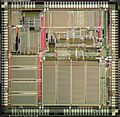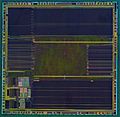ARM architecture facts for kids
ARM architecture is a computer CPU architecture commonly used in embedded systems and mobile devices such as cell phones, tablet computers, and handheld game consoles such as the Game Boy Advance. ARM CPUs use very little electricity and produce very little heat. Most ARM CPUs run on battery power and don't need a cooling fan. The Linux operating system is used most on ARM CPUs.
In 2013 ARM was the world's most popular 32-bit CPU architecture. Since then, production has increased to millions per day. 64-bit ARM, which allows for addressing memory greater than 3.8GB, has been available since then and is used in most modern smartphones.
Contents
Brands and Manufacturers
Examples of products that use ARM
- Most Android devices
- Apple iPhone, iPod Touch, and iPad
- Samsung Chromebook
- Game Boy Advance, Nintendo DS, Nintendo 3DS, and Nintendo Switch
- Windows RT and Windows Phone
- Many Wi-Fi routers and other network equipment
- Digital cameras
- DVD and Blu-ray players
- Some newer televisions
- Some car stereos
- Raspberry Pi, a small $35 computer
Related pages
Images for kids
-
Die of a STM32F103VGT6 ARM Cortex-M3 microcontroller with 1 MB flash memory by STMicroelectronics
-
An ARMv7 was used to power older versions of the popular Raspberry Pi single-board computers like this Raspberry Pi 2 from 2015.
See also
 In Spanish: Arquitectura ARM para niños
In Spanish: Arquitectura ARM para niños








